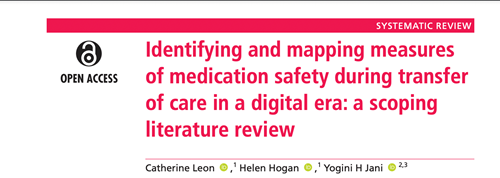When people move between different health and care settings, like going from their home into hospital, this is known as a Transfer of Care (ToC). ToC can pose risks, particularly if a person must take specific medications to stay well; any unintended changes to their medication regime can cause harm. In this blog, Catherine Leon (LSHTM) presents common barriers to safe ToC and how her research is helping to improve medication safety during ToC.
Since 2019, improving medication safety during ToC has been part of the Global Patient Safety Challenge Medication Without Harm. In figures:
 We know that nearly 40% of medication errors occur during ToC, with 20% causing harm
We know that nearly 40% of medication errors occur during ToC, with 20% causing harm
 Between 30 to 70% of people experience a medication error after ToC
Between 30 to 70% of people experience a medication error after ToC
ToC can be challenging for several reasons:
- Communication: Clear and complete communication with many different people is essential, for example between GPs, patients and their families, and hospital-based staff. Problems can occur when communication is inadequate, or patients and their families are not appropriately involved
- High-Risk Medications (HRMs): Some medicines like insulin and anticoagulants pose a higher risk of harm if errors occur. These are High Risk Medications, a group which also includes opioids, sedatives, and chemotherapeutic agents.
Anticoagulants and insulin are:
- Commonly prescribed medicines
- Used for long-term health conditions
- Used in people of all ages
It is likely that people who use insulin and/or anticoagulants will require a hospital admission during their lifetime, and it is essential that these medicines are managed safely during ToC to prevent harm.
How can we improve safety of these medicines during Transfers of Care?
Safety in healthcare is not simply an absence of harm. Instead, it is how all people involved can create positive outcomes, despite challenges relating to what is termed the “work system.”
The work system consists of:
![]() Including patients and their caregivers, paramedics, administrative staff, porters, hospital staff, and all the different teams involved in caring for a patient
Including patients and their caregivers, paramedics, administrative staff, porters, hospital staff, and all the different teams involved in caring for a patient
![]() What must be done to care for a patient, for example, prescribing a medicine, giving a dose of medicine, taking a blood pressure reading
What must be done to care for a patient, for example, prescribing a medicine, giving a dose of medicine, taking a blood pressure reading
![]() Including the medications themselves, electronic health records, telephones, computers, blood pressure monitors, thermometers, trolleys, and any other tool that is needed to treat a patient. It also includes clinical guidelines that support selecting the correct treatments.
Including the medications themselves, electronic health records, telephones, computers, blood pressure monitors, thermometers, trolleys, and any other tool that is needed to treat a patient. It also includes clinical guidelines that support selecting the correct treatments.
![]() These include: the exact location of the patient and everything from its lighting levels, storage space, and location of the computers; organisational environment, which influences how many staff are available and policies and procedures that staff work in accordance with; external environment, such as professional guidelines and legislation.
These include: the exact location of the patient and everything from its lighting levels, storage space, and location of the computers; organisational environment, which influences how many staff are available and policies and procedures that staff work in accordance with; external environment, such as professional guidelines and legislation.
Measurements
There have been many attempts to measure safety, and there are many types of measures used. A combination of different measures is needed to give a fuller picture of safety. Measures can be:
- Lagging measures – measure events that have already happened. These are very useful for giving overall trends over time.
- Leading measures – measure aspects of healthcare that give an indication that something may happen, for example, organisations may look at patient feedback and realise they have been getting information that something needs attention before harm occurs.
- Real-time measures – now many healthcare organisations use electronic systems for health care records, these can be used to highlight in real-time where someone is at risk of harm. An example of this in everyday life is Continuous Glucose Monitors that provide an alarm to people with diabetes if their blood sugar levels drop below a safe level.
We also want a combination of measures that provide information on:
Outcomes: These provide information on the ultimate effectiveness and safety of the healthcare treatment. This could include counting the number of times people need to be re-admitted to hospital for treatment of the same problem or known side effects.
Processes: Process measures capture the rate that certain activities have been completed. These processes involve multiple people and several tasks, for example counting the rate of outpatient appointment attendance. This is a process because it requires that an appointment is booked, the patient is informed, relevant information is communicated with the outpatient team and the patient must travel to and attend the appointment.
Work System: Work system measures capture the rates of single tasks or individual factors relating to the issue being evaluated. For example, it could be the number of staff on a shift, the number of times a task is performed or the number of computers available.


What did we do?
We undertook a literature review, now published in the BMJ Quality and Safety. We searched four databases for any study that aimed to measure how an intervention improved the safety of insulin, anticoagulants, or high-risk medicines during transfer of care. We then examined these studies to identify how improvements in safety were assessed. By mapping the measures, we could see if they were lagging, leading, or real-time and whether they measured outcomes, processes, or the work system, and which aspect of ToC they involved.
Findings
Most measures that have been used to evaluate safety of ToC are lagging measures of outcomes and processes. There were two examples of real-time indicators that were pro-actively used to highlight potential issues to prevent harm. There were very few measures that showed how aspects of the work system were functioning, and therefore the measures don’t provide enough information about where to target projects to improve safety.
What happens next?
This research highlights the need for additional measures based on a detailed understanding of the work system for insulin, anticoagulants, and other high-risk medications. Digital technology provides new opportunities to use data in real-time to highlight areas of potential risk and therefore could provide opportunities for proactively prevent harm.
We are developing a detailed map of the work system that influences insulin is managed during transfers of care when people with diabetes are admitted to hospital and then return home again. As part of this process, all the factors that are impacting on the safe management of insulin are being identified. Once the map is complete, it will be used to find new ways to measure whether insulin is being managed safely during transfer of care.

 06 Nov 2023
06 Nov 2023

